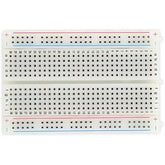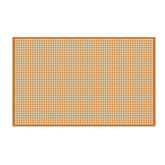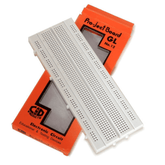What Is a Breadboard? Working, Uses, Types & Best Practices
Summary
Breadboards represent a perfect intersection of accessibility and functionality., while they may look simple. Understanding what is a breadboard is essential for electronics enthusiasts, before these versatile tools existed, testing new circuit ideas meant committing to soldering components together, a time-consuming process that made experimentation tedious and mistakes costly.
The elegance of a breadboard is that it allows for temporary breadboard connections without soldering. Today, whether you're a curious beginner learning how to use a breadboard for your first Arduino project or an experienced engineer studying a breadboard diagram to test complex circuits, these breadboards continue to be that friendly, forgiving workspace where ideas can quickly come to life. The various types of breadboards available accommodate different project needs, making them incredibly versatile.
In this comprehensive guide, we'll explore everything from basic breadboard information and breadboard definition to advanced uses of breadboard in prototyping and even examine how a breadboard works at its fundamental level, helping you understand when it's time to graduate beyond them.
What is Breadboard?
A breadboard is a rectangular plastic board with a grid of tiny holes designed to temporarily hold electronic components and connect them through conductive metal strips underneath.

The name "bread board" actually comes from the early days of electronics when hobbyists would literally hammer nails into wooden boards (often actual cutting boards used for bread) to create connection points for their circuits. Thankfully, we've come a long way since then!

History and Evolution of Breadboards
The modern breadboard we know today emerged in the early 1970s when Ronald J. Portugal invented the solderless breadboard. Before this innovation, electronics prototyping was much more permanent and time-consuming.
In the early days of electronics, creating a circuit meant:
- Using actual wooden boards (yes, the kind used for cutting bread)
- Hammering brass nails into the wood
- Soldering components to these nails
- Making permanent connections that couldn't easily be modified
The evolution of breadboard working principles revolutionized how hobbyists and professionals alike approached circuit design. As transistors and integrated circuits became more common in the 1970s, breadboard designs adapted to accommodate these new components, particularly with standardized spacing for DIP (Dual In-line Package) ICs.
By the 1980s, the fundamental breadboard design we use today was established, with power rails, terminal stripes, and the central channel for integrated circuits becoming standard features found in breadboard information guides.
What are Jumper Wires? Find out now!
Basic Structure and Components of a Breadboard
Understanding the basic structure is key to grasping how a breadboard works. Looking at a typical breadboard diagram, you'll notice several distinct sections:

Power Rails
Running along the edges of most breadboards are the power rails, usually marked with red (+) and blue (-) lines. These long strips allow you to distribute power throughout your circuit. The breadboard connections here run horizontally, parallel to the long edge of the board.
Terminal Strips
The main body of the breadboard consists of terminal strips, organized in rows labeled with numbers and columns labeled with letters. These create the grid pattern you see. In standard types of breadboard, each row of five holes is connected internally by a metal clip.
Central Channel
A defining feature in breadboard working design is the central channel or "ravine" that runs down the middle. This gap separates the board into two halves and provides space for placing DIP (Dual In-line Package) integrated circuits that straddle both sides.
The genius of this design is that it creates a reusable platform where components can be inserted and removed repeatedly without damage. When learning how to use a breadboard, you'll discover that the friction-fit holes hold components firmly enough for testing while allowing for easy modifications.
Understanding these basic elements is the foundation of breadboard information that every electronics enthusiast needs to know. In the next section, we'll dive deeper into exactly how does a breadboard work at the connection level, giving you a complete picture of this versatile prototyping tool.
A Quick note on Integrated Circuits (IC) and Dual In-line Package (DIP)
Once you’ve started prototyping circuits on a breadboard, you’ll quickly notice a certain kind of component showing up again and again—usually a small black rectangular package with little metal legs sticking out of the sides. That’s an IC, or Integrated Circuit, and it’s one of the most powerful tools in your electronics arsenal.

An Integrated Circuit (IC) is essentially a complete circuit—sometimes a complex one—with resistors, capacitors, transistors, and other components all etched onto a single tiny silicon chip. Instead of wiring each piece individually, an IC gives you everything pre-built and neatly packed into one component.

DIP stands for Dual In-line Package. It’s one of the most common physical packaging styles for ICs, especially in DIY electronics. A DIP IC has two parallel rows of pins, spaced so it fits neatly across the middle "trench" of a solderless breadboard. That’s why DIP packages are a favourite when you're learning how to use a breadboard or following a breadboard diagram.
The spacing between pins (typically 0.1 inches apart) matches the breadboard working layout, allowing for easy breadboard connections without any soldering. Just drop it into the board, hook up some jumper wires, and you're good to go.
How are Breadboards Used?
Now, it’s essential to understand how a breadboard works and how they are used if you want to move beyond simply following project diagrams to creating your own circuits. So, let’s take a look under the surface to see what makes these prototyping tools so brilliantly functional.
The Fundamental Structure of a Breadboard
A breadboard consists of a thin plastic board designed specifically to hold wired-together electronic components such as transistors, resistors, integrated circuits, and more. What makes a bread board unique is its internal connection system. Beneath the surface lies a network of spring-clip connections that create electrical pathways between components inserted into the holes.
When examining a breadboard diagram, you'll notice these spring clips are arranged in specific matrices, with certain blocks already connected internally. Some breadboards
feature transparent plastic casings that allow you to see these internal clips. Most have a sturdy backing layer that prevents the metal clips from slipping out during use.

Creating Connections
The beauty of breadboard working principles lies in their simplicity. Each group of holes connected by a metal strip underneath forms what's called a node. Understanding these nodes is crucial breadboard information for beginners. To create connections between multiple components, you simply insert their leads into a shared node.

When learning how to use a breadboard, you'll discover that the long holes running along the top and bottom rows typically serve as power rails for distributing power throughout your circuit. These power rails represent one of the most useful aspects of breadboard connections, allowing you to easily power multiple components simultaneously.
The central dividing line on a breadboard serves a specific purpose in the types of breadboard design. Integrated circuits (ICs) are positioned straddling this central line, with half of the legs on one side and half on the other. This arrangement keeps the IC pins electrically isolated from each other while making them accessible for connections.
The remainder of your circuit is constructed by strategically positioning components and using jumper wires to connect them according to your design. This flexibility is what makes breadboard working so valuable for prototyping.

Breadboards Alongside Arduino and Raspberry Pi
In today's electronics landscape, breadboards still have a place alongside modern microcontrollers. Nearly all introductory electronics courses now incorporate either Arduino or Raspberry Pi platforms, but the uses of breadboard prototyping still remain relevant.

While a Raspberry Pi can perform many functions without additional hardware, the most interesting applications emerge when microcontrollers are combined with supplementary electronic circuits built on breadboards. For instance, instead of running the default Arduino Blink sketch that uses an onboard LED, beginners often create their first external circuit by connecting an actual LED and resistor on a breadboard.
Types of Breadboards
It’s crucial to understand that not all breadboards are equal. They generally fall into two broad categories: solder and solderless.
Solderless Breadboards:
Solderless breadboards are what most beginners—and even seasoned tinkerers—reach for first. Why? Because they make trying out ideas fast and reversible. Components and jumper wires can be pushed into the tiny spring-loaded holes on the board to form a circuit, no permanent commitment needed.
It's like the dry-erase board of electronics: if something doesn’t work, just pull it out and try again. This is the kind of breadboard you’ll use for experimenting with an Arduino, testing an LED matrix, or mocking up a sensor system.

Solder Breadboards:
Once your circuit idea is solid and tested, you might want to make it more permanent. This is when you use soldered breadboards. Here, you solder electronic components and wires directly to the board, locking your design into place.

Advantages of Breadboards
Understanding what is a breadboard goes hand-in-hand with recognizing its capabilities and limitations. Like any tools, it’s not perfect for every situation.
- Solderless simplicity: One of the biggest advantages of a breadboard is that it requires no soldering. This means you can quickly assemble, disassemble, and reconfigure circuits without making permanent changes—ideal for testing and prototyping.
- Reusable & beginner-friendly: Because the components aren’t soldered in place, you can reuse the board and all your components over and over. This makes learning how to use a breadboard easy and cost-effective.
- Easy to modify: The ability to make rapid changes is at the heart of breadboard working. Whether you’re debugging or upgrading your design, all it takes is a few wire swaps or component shifts.
- Lightweight and compact: Most types of breadboard are made from white ABS plastic and are lightweight yet sturdy, perfect for bench setups.
- No drilling required: The board comes pre-punched with a grid of holes designed for through-hole components, saving you from manually drilling or preparing a board.
- Wide component compatibility: From resistors and capacitors to ICs and LEDs, breadboard connections support a variety of components. And yes, even small microcontrollers can be tested here.
- Available in various sizes: Whether you need a mini bread board for a small LED flasher or a full-sized one for a more complex project, you’ll find one that suits your build.
- Affordable and accessible: One of the key uses of breadboard is its role in education and DIY electronics, thanks to its low cost and wide availability.
Disadvantages of Breadboards
- Limited to low-current applications: Breadboards aren't built for high power—too much current can overheat the contacts or damage components.
- Not suitable for high-frequency designs: Curious how a breadboard works at the signal level? Unfortunately, not well at high frequencies. Stray capacitance and inductance between rows can interfere with signal integrity, making them unsuitable for RF or high-speed designs.
- Messy with complex circuits: A lot of breadboard connections in a tight space can lead to spaghetti wiring. It becomes hard to follow the logic of your circuit, especially without a clean breadboard diagram.
- Takes more physical space: Even simple circuits can take up significant room on a breadboard, especially compared to a custom PCB.
- Prone to loose connections: Because all connections are pressure-fitted, accidental bumps or repeated plug/unplug cycles can lead to unreliable performance.
- Interference from movement: Plugging or removing one component can sometimes disturb others, especially in a dense layout.
- Not ideal for SMD components: Most breadboard information focuses on through-hole parts. Surface Mount Devices (SMDs) don’t naturally fit without adapters.
When not to use a Breadboard
While the breadboard is a go-to tool for prototyping and experimentation, it has its limits. Breadboards are ideal during the early stages of a project, where you're learning how a breadboard works, testing ideas, or troubleshooting circuits. But once you move toward creating a final product, especially one that's sensitive, safety-critical, or intended to last, you’ll need to graduate beyond the bread board.
- The final design requires long-term stability: Electronic components on a breadboard are held in place only by friction. A slight tug or bump can break breadboard connections, making them unreliable for permanent setups.
- Safety is involved: If you’re working with high voltages, controlling mains power, or wiring up emergency stop systems, a breadboard is not safe. A disconnected wire in such cases isn’t just an inconvenience—it’s dangerous. Remember, how a breadboard works involves temporary, non-soldered connections, which are not suitable for safety systems.
- There’s physical movement or vibration: Environments with vibration can loosen connections on a breadboard. That’s why uses of breadboard should be limited to static testing benches—not mounted inside moving devices or systems with mechanical stress.
- You're working with high-frequency circuits: One common beginner mistake is attempting to build RF circuits on a breadboard. Due to the internal layout and row-to-row capacitance (which can reach up to 10pF), high-speed signals become distorted or fail altogether. As a rule of thumb, avoid using a breadboard for anything above 10MHz.
- Your circuit uses surface mount (SMD) components: Most types of breadboard follow a standard 2.54mm (0.1 inch) pitch and are meant for through-hole components. If your design relies on SMD parts, you'll either need special adapter boards or a PCB. Using a breadboard here only complicates things and wastes valuable components.
Beyond Breadboards: Next Steps in Circuit Development
Veroboards and Protoboards

In your electronics prototyping journey, you will inevitably reach a point where you want your project to outlast a temporary breadboard setup. While understanding how a breadboard works is essential in the early stages, it’s equally important to know what comes after. That’s where Veroboards and Protoboards come in.
Think of them as the structured, more developed version of a breadboard. Unlike a bread board, which allows temporary breadboard connections, Veroboards require you to solder components in place—so yes, this is a more permanent solution. They’re perfect for intermediate builders who’ve nailed down their breadboard diagram, validated the design, and are now ready to build something that won’t fall apart when moved.
Transitioning to PCBs (Printed Circuit Boards)

For those ready to take their projects to a truly professional level, PCBs (Printed Circuit Boards) represent the natural progression from both breadboards and Veroboards. While types of breadboard all share the limitation of being temporary prototyping platforms, PCBs are custom-manufactured specifically for your circuit design.
The journey from breadboard working prototype to PCB begins with transferring your validated breadboard connections to specialized design software.
Unlike the visible breadboard information and connections you can physically trace with your eyes, PCBs feature copper traces that are etched onto layers of fiberglass substrate, creating a compact, reliable, and permanent implementation of your circuit.
Modern PCBs also allow for surface-mount components, multi-layer designs, and specialized features that simply aren't possible when learning how to use a breadboard or even with intermediate solutions like Veroboards.
When your project deserves professional-grade reliability and you've outgrown the uses of breadboard prototyping, PCBs become the natural destination for your electronics designs.
Protoboard vs. Breadboard
You can build circuits by soldering components into position and connecting them with wire or additional solder on these boards' copper-ringed holes.
The method for building a circuit using a stripboard is like that as breadboards. Components and are better held in place, however, this building method could potentially be more difficult.

A breadboard enables the designer to insert an expensive item (such as a microprocessor in a DIP package), build the circuit, test it, and then quickly remove the pieces to be reused in another project, recovering the component cost.
In contrast, Board circuits make use of IC sockets, where ICs are inserted and soldered in place semi-permanently. While these ICs may be removed for future use, stripboards are challenging to recycle.
Conclusion: Why Every Electronics Enthusiast Needs a Breadboard
If you're into electronics, the breadboard is your creative playground. It lets you build, tweak, break, and rebuild circuits without a single drop of solder. Constructed from durable materials like ABS plastic or acrylic, these boards are packed with tiny holes known as tie-points or connection pins that allow you to easily insert components like resistors, capacitors, ICs, transistors, and LEDs. This grid-like layout is what makes the breadboard working process so intuitive, especially for prototyping.
One of the best things about learning how to use a breadboard is the freedom it gives you to experiment fearlessly. Made a mistake? Just pull a wire. Want to try a new design? Reuse the same space. This reusability is at the heart of what makes breadboards perfect for both beginners learning about breadboards and experienced builders testing advanced circuits.
In the world of electronics, there's always more to learn—and more to build. So whether you're sketching out your first circuit or fine-tuning a complex breadboard diagram, having a breadboard nearby is practically essential. If you don't already own one, it's definitely time to add this classic tool to your bench.
If you appreciate our work don't forget to share this post and leave your opinion in the comment box.
Please do check out other blog posts about Popular electronics
Make sure you check out our wide range of products and collections (we offer some exciting deals!)








